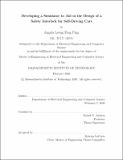Developing a simulator to aid in the design of a safety interlock for self-driving cars
Author(s)
Leong Feng Ping, Angela.
Download1237530447-MIT.pdf (3.048Mb)
Other Contributors
Massachusetts Institute of Technology. Department of Electrical Engineering and Computer Science.
Advisor
Daniel N. Jackson.
Terms of use
Metadata
Show full item recordAbstract
Self-driving cars have tremendous potential to be safer than human drivers, but are complex systems for which evaluating safety is challenging: using a statistical approach requires self-driving cars to have clocked on the order of billions of miles of driving to present convincing evidence. Thus there is potential in exploring a new design architecture for self-driving cars in which a small, trusted module of code cooperates with the main controller to ensure safety while being easily verifiable; we call this the safety Interlock. This thesis focuses on the scenario of an ego car driving in a single, straight lane behind a lead car that may suddenly brake. We first propose and prove, using formal verification, an algorithm for Interlock to prevent collision by maintaining a safe separation distance that allows the ego car to stop in time. We then present a simulation program developed using the Processing programming language, which provides visual confirmation of the efficacy of the Interlock algorithm, and is designed to be extensible to more complex road scenarios.
Description
Thesis: M. Eng., Massachusetts Institute of Technology, Department of Electrical Engineering and Computer Science, February, 2020 Cataloged from student-submitted PDF of thesis. Includes bibliographical references (pages 77-78).
Date issued
2020Department
Massachusetts Institute of Technology. Department of Electrical Engineering and Computer SciencePublisher
Massachusetts Institute of Technology
Keywords
Electrical Engineering and Computer Science.